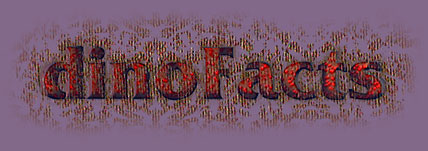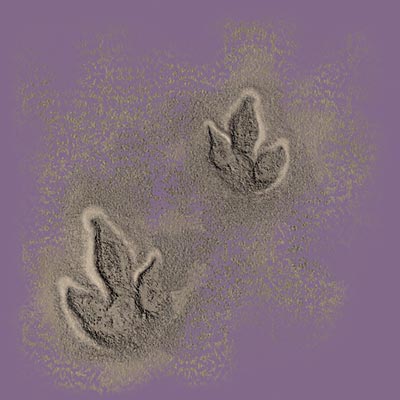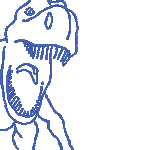
The word "dinosaur"
is from the greek words "déinos" = fearfully great, and "sauros" = lizard.
And that conception originates from 1842 when there only where three different
dinosaurs discovered. And those where all very large and, with a little
imagination, "fearful". Today are the knowledge a little bit deeper. Not
all dinosaurs are large, as we are about to see. What defines a dinosaur?
If we are going for the narrow and ultimately correct definition, he is
not able to fly or swim. At least not live primarely in the water. It
has to have the ability to bear its own weight on its own feet. And move
with those feet only. That makes them different from other closely related
species. And especially these that where before the dinosaurs. Some 360
million years ago did it not exist any dinosaurs at all. If you can imagine
a crocodile that suddenly leaves the water and rises on its feet and starting
to walk around, you have some good imagination, for sure. It took about
130 million years to develop a water-living froglike kind of creature
into a dinosaur. The earliest dinosaur known today are from 228-230 million
years ago. And those mostly known are from about 150 million years ago
until 65 million years ago. Then they vanished. And all of a sudden it
seems. No one knows exactly why they disappeared. It is one of the mysteries
of earth. Some believes a sudden breakdown of giant asteroids could have
changed the environment in such a way that many of the inhabitants of
earth where unable to cope. There are also possibilities that some of
them developed into birds, since there are a lot of similarities. All
we are sure of and really know about them are the facts we get from the
fossils. Footprints, structure of skin and more or less complete skeletons
give us information. Those dinosaurs that where unable to leave any fossils
will remain unknown. About 800 different dinosaurs have been kind enough
to let us know about them! And if people has patience to continue digging
all around the earth, are the chances good that we will get to know some
more.
Here are examples of twelve of them we at least know something about:

ALLOSAURUS:
Length 12 m, height 5 m. Weight 1400-3000 kg. Some as heavy as 5000 kg.
Meateater, and one of the largest of them. Long sharp teeth. Three clawlike
fingers on each hand with about 15 cm long sharp claws! Relatively high
intelligence according to brainsize. Lived about 150 million years ago.
May have been a fast running dinosaur, but experts are not united in that
opinion.
ANKYLOSAURUS: Length 7-11 m, height 1,2 m. And width almost 2 m. Really heavy with a weigth of 3000-4000 kg. Almost totally covered in plates except for the lower body. Only weak spot therefore seems to have been the belly area. Lived for 70-65 million years ago. Did only eat plants and such. Not an overly intelligent creature nonetheless. Small brain.
BRACCHIOSAURUS: Length 26 m, height 16 m. Weight 30000-80000 kg! Yes, this was one of the absolutely largest creatures that ever lived. Three times as tall as a giraffe will give you an idea of the size. Did not eat meat. Only pines and such, probably from high trees. They did not chew the food. It had to digest it in the stomach. Believed to be one of the less intelligent dinosaurs. But no real enemies due to the large size. Could be attacked by smaller dinosaurs at rare occasions, for example allosaurus. But that was probably something that the allosaurus tried to avoid if possible. The bracchiosaurus did not have any defense, but the size, weight and also length of tail and anterior legs did imply some serious trouble for any attacker. The size helped to keep temperature constant. Complicated heart and vessel construction due to the height which required really high blood pressure. Lived about 140-156 million years ago. Maybe too heavy to have lived at the absolute waterfront which sometimes has been believed.
COMPSOGNATHUS: Length 0,65-1,45 m. Weight 3 kg. Did eat meat, mostly insects and smaller animals. Possibly fast and quick. Was one of the smallest dinosaurs. Lived 155-145 million years ago.
CORYTHOSAURUS: Length 9-10 m, height 2 m. Weight 4000 kg, sometimes more. Beak with smaller teeth mostly located at the cheeks. Did not eat meat. Believed to walk booth on all four legs, and sometimes on two. Intelligence should be medium according to brainsize. Lived 80-65 million years ago.
ICHTYOSAURUS: Length 4,5-9 m. Lived in the water and therefore not really defined as a dinosaur. Sharp teeth, ate fish and octopuss. Probably good sigth due to large eyes which indicated that it lived relatively close to the land. Body construction let us know that the swimming speed should have been really fast, maybe as high as 40 km/hour. Did not lay eggs like fish do, but living children like dolphins and whales. Lived about 95 million years ago.
KENTROSAURUS: Length 5 m. Weight about 2000 kg. Beak and small teeth in the cheek area. Both spikes as weapon and plates for defense and maybe cooling. Believed to be slow and have minor intelligence but good abilities differentiating smells. Walked on all four. Ate plants, mostly lower growing since the head was held really low. Lived 155 million years ago.
OVIRAPTOR: Length 1,8-2,5 m. Weight 25-35 kg. Two long legs for fast running and two shorter arms for action. 8 cm long claws on the hands. No teeth really, but two minor "pegs" in the upper palate. Otherwise a strong beak. Probably able to reach speeds around 70 km/hour. Also believed to have one of the largest brains in proportion to the overall size. That could be handy when it has eggs to protect, and that is probably why the oviraptor on the "intro" page are looking anxiously over the shrubs. The oviraptor ate meat as well as plants, insects and seed. Probably also eggs, but not in the degree that the name implies. It means "egg thief". Lived 88-70 million years ago.
PTERODACTYLUS: A flying reptile, and as such not really a dinosaur per se. Nevertheless around at the same time as the dinosaurs and at the same places mostly. Preferably at the shores as it seems to have liked fish. And maybe small animals. Wingspan of about 0,75-1 m. Lightweight. Had the ability to fly long distances. Lived 150 million years ago.
STEGOSAURUS: Length 8-9 m, height 2,75 m. Weight about and sometimes exceeding 3000 kg. Small brain. Sharp spikes for protection and flat plates for something. Maybe protection as well, or adjust temperature. Blood could have been circulated in them and get some cooling that way. The best finding of a stegosaur fossil was done in 1992 when the position of the plates could be understood as standing in an alternating order. Small brain. Ate plants, but was equipped for fight nonetheless. Lived 156-140 million years ago.
TRICERATOPS: Length 9 m, height 3 m. Weight 6000-12000 kg. Had one of the largest heads of any animal ever. Two long spikes and one shorter. Probably very slow most of the time due to the weight. Did not eat meat. Mostly lower growing shrubs and plants, since the head was placed low. Believed to have swallowed small stones and gravel to help digest the food. Lived 72-65 million years ago.
TYRANNOSAURUS REX: Length 12,5 m. Height 5-6 m. Weight 5000-7000 kg. This is maybe the most famous of the dinosaurs, or should we say infamous. One of the absolutely largest carnevours (meat eaters). Slightly larger than the allosaurus, who lived long before him. Combine the long sharp teeth, often 25 cm or more. With strong legs, huge jaws, sharp claws on the feets and a really good sight. And you may understand that this creature was a killer. As most of the meat-hunters had their eyes directed straight forward, so did the t rex. That gives very good sense of depth and distance. Many of their victims was plant eating creatures with eyes placed and directed more to the sides. This gives nice overall viewing angle, good if you have problems swinging your head from side to side, but much poorer indication of depth. So the carnevours had a lot of things that made them able in their task. And one of the most able of them all should have been the t rex.
If you would like to see what the above dinosaurs look like, go here. And you will see that they have come a long way since they first crawled up from the seas.

 go to dinosarie startpage
go to dinosarie startpage go to site startpage
go to site startpage
copyright © 2012, peter goransson

